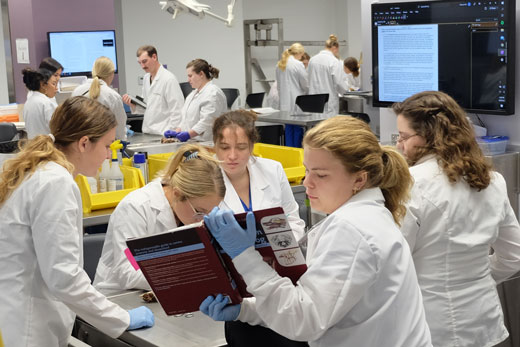September 14, 2022
Veterinary professors zoom in on unique way to answer anatomy questions
 |
First-year veterinary students work in groups in the anatomy lab. When students have questions, a new Zoom-based tool connects them quickly with the instructors, facilitating better learning. |
Four professors with the College of Veterinary Medicine have published the article "Novel Method to Manage Student Questions in the Anatomy Laboratory Using a Virtual Meeting Platform" in the Journal of Veterinary Medical Education, which explains how they use virtual meeting tools to help students in anatomy lab courses.
The professors, all from the College of Veterinary Medicine's anatomy and physiology department, wanted to find a way to answer questions more quickly from students in anatomy laboratory courses.
"We brainstormed amongst ourselves, and with the technical support people in the veterinary college, came up with Zoom as an option," said Judy Klimek, clinical professor of anatomy and histology. This was before the pandemic, so at that time I didn't even know what Zoom was."
Pradeep Malreddy, clinical assistant professor of anatomy and physiology, said instructors were originally thinking about developing an in-house queue management software, similar to what you might see at the local motor vehicle office.
"Our IT director, Bryan Kraus, and his team came up with Zoom Webinar's Q and A feature after consulting with colleagues," Malreddy said. "Our department head, Dr. Hans Coetzee, graciously funded the purchase of mini iPads and a Zoom Webinar license."
Zoom Webinar allows the instructors to log in as panelists on a mobile device and then interact with the students who are logged in as attendees" via the Q and A feature.
"Our students join the webinar using their dissection table number as their ID and request assistance in the Q and A," Malreddy said. "The questions go into a time-stamped list, to which the instructors can reply with a text, which can be seen live by the other instructors. This allows student questions to be queued so that the instructors can address them in a timely, first-in, first-out order and also allows that group to see that someone is coming to assist them."
Malreddy said student feedback regarding the use of this system for the Small Animal Anatomy course was positive.
"Once we started using Zoom, we loved it for the most part," Klimek said. "Despite some minor hiccups while getting everyone used to using it, we thought others veterinary educators could benefit from hearing about it."
Klimek and Malreddy collaborated with Lynn Abel, clinical assistant professor of anatomy and physiology, and Cathy Sparks, former College of Veterinary Medicine faculty member, to formally write up an article for the Journal of Veterinary Medical Education.
"Dr. Abel provided many of the solutions and suggestions during the implementation process," Malreddy said. "I started collecting data to see how many questions were being answered and by whom. Dr. Sparks wrote an abstract that was to be presented at the Veterinary Educators Collaborative Symposium in 2020, but that got canceled due to COVID. So, two years later, here we are, and we have just published our findings."
